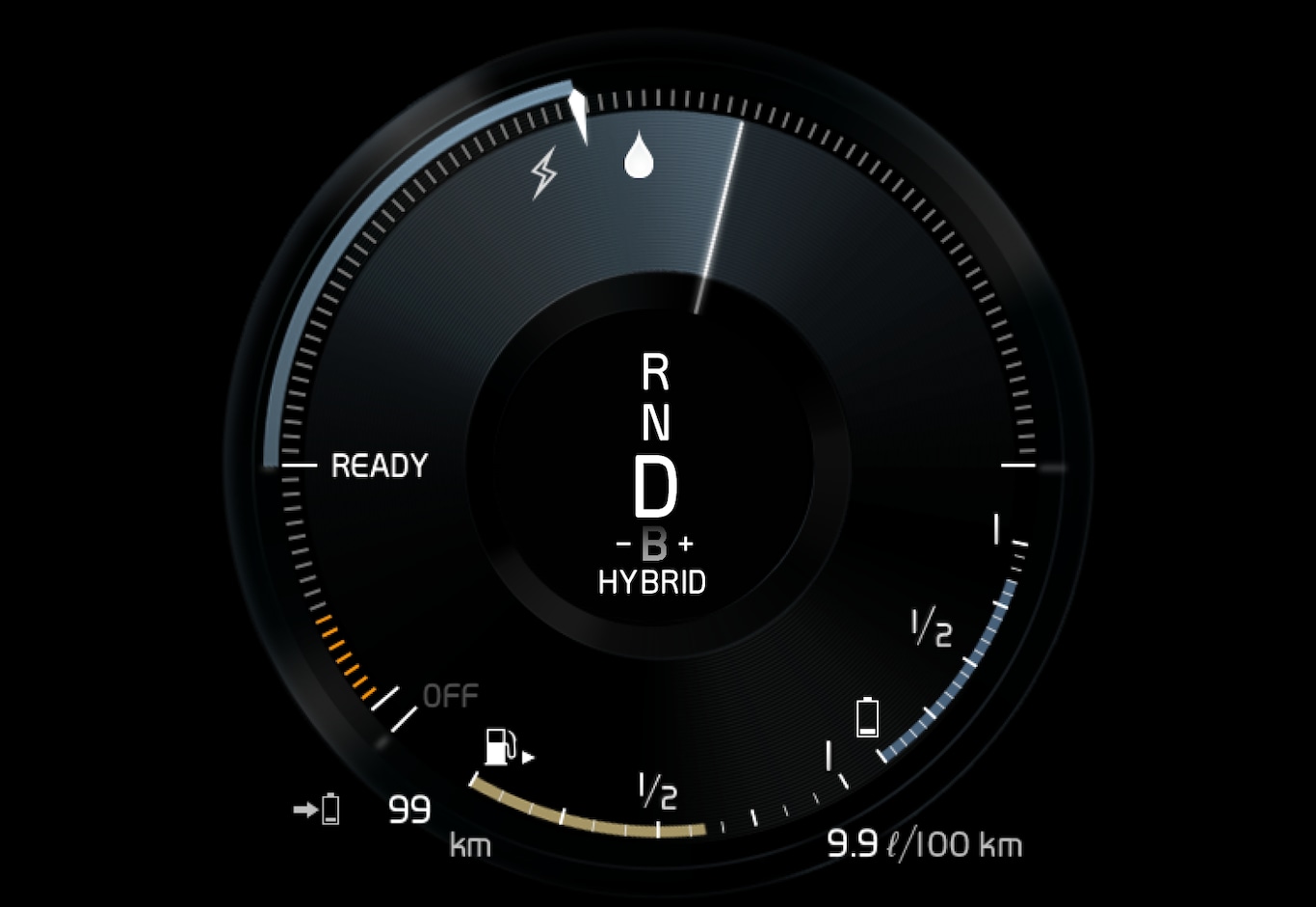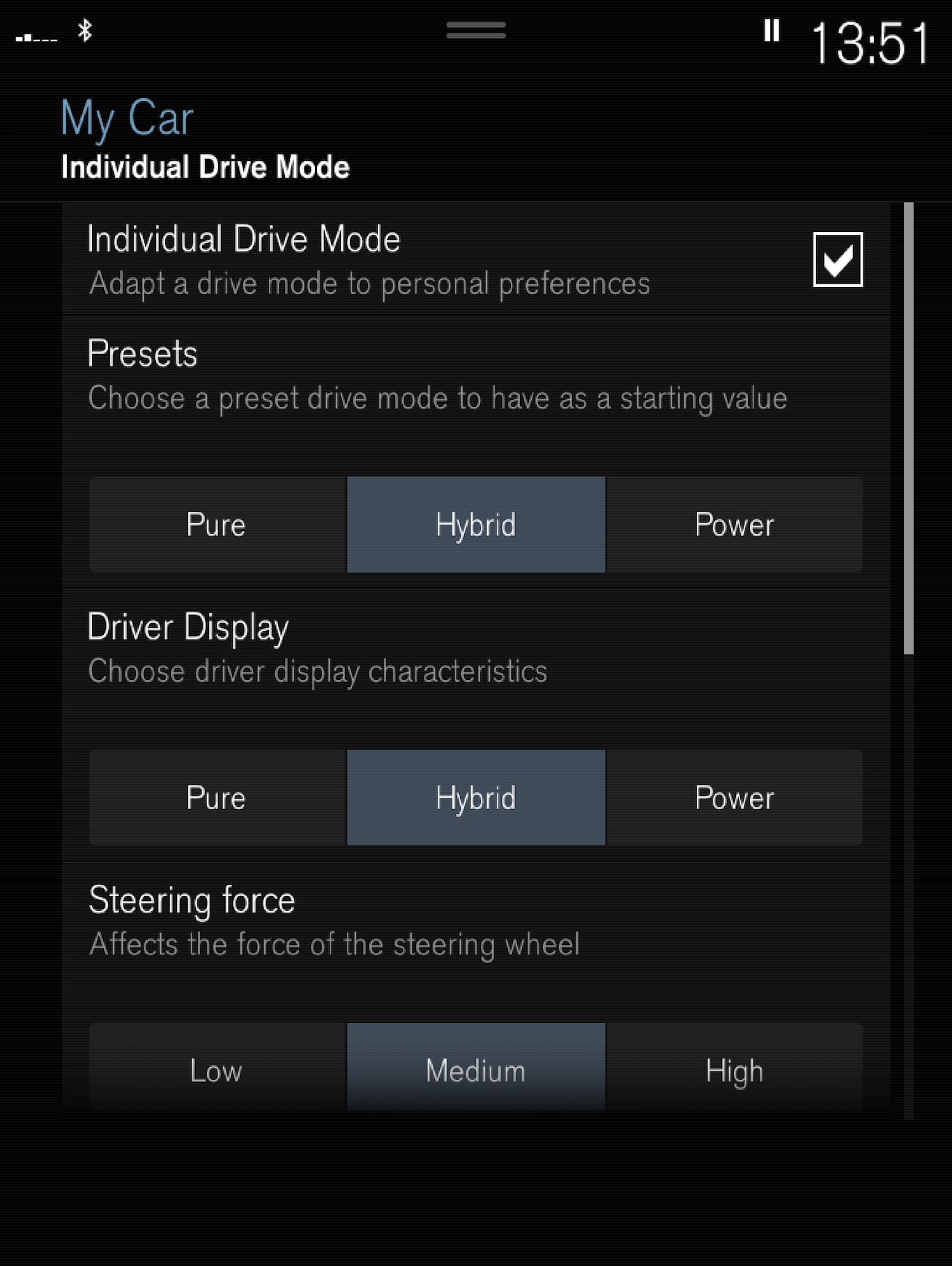Using the drive modes it is possible to quickly have access to the car's numerous functions and settings for different driving needs. Each drive mode is adapted to provide optimum driving characteristics:
- Steering
- Engine/gearbox/all-wheel drive
- Brakes
- Air suspension* and shock absorption
- Driver display
- Climate settings
Select the drive mode adapted for the current driving conditions. Remember that not all drive modes are available in all situations.
Selectable drive modes
Warning
Warning
Hybrid
- This is the car's normal mode where the electric motor and internal combustion engine work together.
When the car starts, it is in the Hybrid mode. The control system uses both the electric motor and internal combustion engine – individually or in parallel – and adapts use with regard to performance, fuel consumption and comfort. At higher speeds the ground clearance is adjusted automatically to a lower level1 in order to reduce wind resistance. The capacity to run solely with the electric motor depends on the hybrid battery's energy level and, for example, the need for heating or cooling in the passenger compartment.
If high power output is available, it is possible to drive with electrical power alone. When the accelerator pedal is depressed, only the electric motor is activated until a certain position is reached. The internal combustion engine starts when this position is exceeded and the energy level in the battery is insufficient for the engine power that the driver requests with the accelerator pedal.
At low energy level (hybrid battery almost empty) the battery's energy level must be maintained, leading to the internal combustion engine starting more often. Charge the hybrid battery from a 230 VAC socket with the charging cable, or activate Charge in the function view in order to restore the capacity to run on electricity alone.
The drive mode is designed for low energy consumption with a mix of the electric motor and the internal combustion engine, without compromising the climate comfort and driving experience. When higher acceleration is required, maximum additional power from the electric drive line is used.
The car also senses if the driving conditions require all-wheel drive and automatically engages it if necessary. All-wheel drive and electric additional power are always available regardless of the battery's state of charge.
Information in the driver display
When driving in hybrid mode the driver display shows a hybrid gauge. The pointer in the hybrid gauge indicates how much energy the driver requests with the accelerator pedal. The marking between the lightning bolt and the drop shows how much energy is available.


The driver display also shows when energy is returned to the battery (regenerated) during light braking.
Pure
- Drive the car with electric motor, with energy consumption as low as possible and with lowest possible carbon dioxide emissions.
The drive mode prioritises driving on the hybrid battery. This means, for example, that the ground clearance is lower1 to reduce wind resistance and the output of certain climate settings is reduced to provide the longest possible mileage range on electric power alone.
The Pure mode is available when the hybrid battery has a sufficiently high energy level. The internal combustion engine also starts in the Pure mode if the energy level in the battery falls too low. The internal combustion engine also starts
- if the speed exceeds 125 km/h (78 mph)
- if the driver requests more motive force than electric drive can provide
- in the event of system/component limitations, e.g. low outside temperature.
The drive mode is adapted for maximum range with electric propulsion and especially developed for urban traffic. Pure means lowest combustion even when the hybrid battery is empty. The climate in the passenger compartment is regulated to Eco climate, and in slippery driving conditions, more wheel spin can be permitted before all-wheel drive is activated automatically.
ECO climate control
In the Pure drive mode, eco climate control is activated automatically in the passenger compartment in order to reduce energy consumption.
Note
In the event of difficulties due to misting, press the button for max. defroster which has normal functionality.
Off Road
- Prioritise the car's traction when driving in difficult terrain and on poor roads.
The drive mode provides high ground clearance1, steering is light, all-wheel drive and the function for low speed control with hill descent control (Hill Descent Control) are activated.
The drive mode is only available at low speeds, up to 40 km/h (25 mph). If this speed is exceeded, Off Road mode is cancelled and the Constant AWD drive mode is activated instead.
To be able to drive all four wheels, the internal combustion engine and electric motor run continually, which results in increased fuel consumption.
In the Off Road mode the driver display has a compass between the speedometer and tachometer. The speedometer shows the range for speed limitation.
The drive mode is adapted for maximum controllability at low speeds in poor road conditions or difficult terrain. It raises the chassis1, reduces the driveline's throttle response and locks the car in all-wheel drive. The Hill Descent Control function facilitates controlled driving on steep descents.
Note
Note
Important
Constant AWD
- Improve the car's roadholding and traction with enhanced all-wheel drive.
The drive mode locks the car in all-wheel drive. An adapted distribution between the front and rear axle torque provides good traction, stability and roadholding, for example on slippery roads, when driving with a heavy trailer, or when towing. Constant AWD drive mode is always available regardless of the battery's state of charge.
Both the internal combustion engine and electric motor are engaged in order to drive all four wheels, which results in increased fuel consumption.
In the car's other drive modes, the car automatically adapts the need for all-wheel drive to the road surface, and can engage the electric motor or start the internal combustion engine when necessary.
Power
- The car has sportier characteristics and faster response to accelerating.
The drive mode adapts the combined power from the internal combustion engine and electric motor by means of the car being driven by both front and rear wheels. The gear changes become faster and more distinct, and the gearbox prioritises a gear with greater traction. Steering response is faster, shock absorption is harder and a lower ground clearance1 means that the body follows the roadway in order to reduce roll during cornering.
Both the internal combustion engine and electric motor are engaged in order to drive all four wheels, which results in increased fuel consumption.
The drive mode is adapted for maximum performance and response on acceleration. It changes the internal combustion engine's accelerator pedal response, gear shift pattern and boost pressure system. Chassis settings, steering and brake response are also as good as possible. Power drive mode is always available regardless of the battery's state of charge.
The Power mode is also available in the Polestar Engineered version*.
Individual
- Adapting a drive mode according to individual preferences.
Select a drive mode to start from, and then adjust the settings according to the desired driving characteristics. These settings are saved in an individual driver profile.
An individual drive mode is only available if it is first activated in the centre display.

In Presets, select a drive mode to start from: Pure, Hybrid, Power or Polestar Engineered*.
Possible adjustments apply to settings for:
- Driver Display
- Steering Force
- Powertrain Characteristics
- Brake Characteristics
- Suspension Control
- ECO Climate
Using the electric motor or internal combustion engine
An advanced control system determines the extent to which the car is driven on internal combustion engine, electric motor or both in parallel.
The primary function is to use the engine or motor and the available energy in the hybrid battery as efficiently as possible, with regard to the characteristics of the different drive modes as well as the driver's request for power via the accelerator pedal.
There are also cases where temporary limitations in the system, or functions governed by legal requirements aimed at maintaining a low level of total emissions for the car, may use the internal combustion engine to a greater extent.